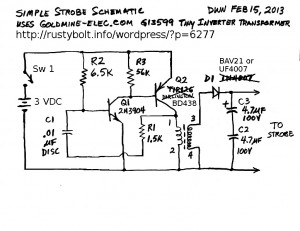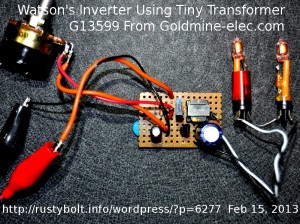I received the bag of these tiny inverter transformers that I ordered from goldmine-elec.com. Each was tiny: 10.7mm wide, 10mm deep, and 9mm high, not counting the leads. There are two windings, the primary which is 0.11 ohms and an unknown inductance, and the secondary which is 48.4 ohms and 350 mH.
 They sent a single page along with the pinout and a schematic of a strobe using this transformer. I redrew the schematic since it was oddly drawn, and I’m going to make some modifications to it. They made some fundamental mistakes that I’m going to correct. The first mistake was to use a TIP126 Darlington transistor for the driver transistor (my earlier blog explains why). The supply is only three volts, and .6 volts of that is wasted across the TIP126, as heat – that’s 20 percent!. The first thing to do is get rid of the Darlington. I’m changing it to a BD438 PNP transistor. I will also change the 2N3904 to a PN2222A. Then I have some doubts about the values of R2 and R3. R2 is low for the bias resistor for a small transistor.
They sent a single page along with the pinout and a schematic of a strobe using this transformer. I redrew the schematic since it was oddly drawn, and I’m going to make some modifications to it. They made some fundamental mistakes that I’m going to correct. The first mistake was to use a TIP126 Darlington transistor for the driver transistor (my earlier blog explains why). The supply is only three volts, and .6 volts of that is wasted across the TIP126, as heat – that’s 20 percent!. The first thing to do is get rid of the Darlington. I’m changing it to a BD438 PNP transistor. I will also change the 2N3904 to a PN2222A. Then I have some doubts about the values of R2 and R3. R2 is low for the bias resistor for a small transistor.
R3 doesn’t seem necessary because the TIP126 has built-in resistors across the base to emitters of both transistors. But since I’m changing it to a BD438, I think it could be lower. It has passed through my thoughts more than once that it looks like the values for R2 and R3 may have been switched. But the 6.5k looks like it should have been 5.6k. I think R3 could be 1k and not waste much power.
I have changed the R2 to a 10k in series with a 100k pot. I adjusted it to about 10k, so the total R2 is about 20k. I changed the C1 capacitor from .005 uF to .001 uF. That blue capacitor can be seen peeking out from under the circuit board.
The BAV21 or UF4007 is just to reduce the losses from slow reverse recovery of the 1N4007. The C2 and C3 capacitors need 1 meg or 470k resistors to bleed off the high voltage when the circuit is not operating. Also, the resistors would equalize the voltages across C2 and C3. But I am not going to use two capacitors in series, I will use a single 10 uF capacitor, rated at 350 volts.
 I connected two NE-2 pilot lamps in series and connected them across the output as a load. Each lamp has a 33k resistor in series with it. I measured the voltage drop across one 33k at 14 volts, so the current through them is 0.42 milliamps. As can be seen, they light up brightly. The supply current at 3 V was about 200 milliamps.
I connected two NE-2 pilot lamps in series and connected them across the output as a load. Each lamp has a 33k resistor in series with it. I measured the voltage drop across one 33k at 14 volts, so the current through them is 0.42 milliamps. As can be seen, they light up brightly. The supply current at 3 V was about 200 milliamps.
Back to experimenting…
Update – I used this transformer in my blog about the “Joule Thief” that is powered by a 40 millivolt thermocouple.
Thanks for the specs on those transformers. I calculated that the primary is 78.75uH and created a LTSpice model that matches the 3:200 claim. Will send it to you if you like.
Calc: 3:200 voltage is 1:66.67 turns ratio; 1:N turns ratio means 1:N^2 inductance ratio of 1:4444.4; so primary=350mH/(66.67^2)=78.75uH.
Thanks for the info.
I have tried many times to measure the L of those high turns ratio transformers with my LC meters. I usually get a value that is negative and/or far from a reasonable value. I think this is because the testing frequency is above the winding’s self-resonant frequency and it looks like capacitive reactance. In any case the measurement is useless. Your formula for calculating the L appears to be a much better way to go.